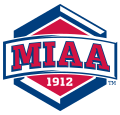| Fort Hays State Tigers | |
|---|---|
 | |
| University | Fort Hays State University |
| Conference | The MIAA (primary) GAC (men's soccer) |
| NCAA | Division II |
| Athletic director | Lisa Goddard McGuirk |
| Location | Hays, Kansas |
| Varsity teams | 18 |
| Football stadium | Lewis Field |
| Basketball arena | Gross Memorial Coliseum |
| Baseball stadium | Larks Park |
| Mascot | Victor E. Tiger |
| Nickname | Tigers |
| Colors | Black and gold [1] |
| Website | fhsuathletics |
 | |
The Fort Hays State Tigers are the athletic teams that represent Fort Hays State University, located in Hays, Kansas, in intercollegiate sports as a member of the NCAA Division II ranks, primarily competing in the Mid-America Intercollegiate Athletics Association (MIAA) for most of its sports since the 2006–07 academic year; [2] while its men's soccer team competes in the Great American Conference (GAC). The Tigers previously competed in the Rocky Mountain Athletic Conference (RMAC) from 1989–90 to 2005–06 (which they were a member on a previous stint from 1968–69 to 1971–72); in the Central States Intercollegiate Conference (CSIC) of the National Association of Intercollegiate Athletics (NAIA) from 1976–77 to 1988–89; in the Great Plains Athletic Conference (GPAC) from 1972–73 to 1975–76; in the Central Intercollegiate Athletic Conference (CIC) from 1923–24 to 1967–68; and in the Kansas Collegiate Athletic Conference (KCAC) from 1902–03 to 1922–23.



